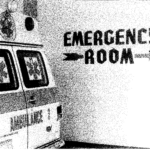The Dark Side of the ED
I met her in the checkout line at the supermarket.
“You fixed my son’s hand,” she said.
“How is he doing?”
“Good. You did a good job.”
“Remind me of his injury.”
Once I heard the history, I remembered him. I don’t always remember a face, but I nearly always remember a patient’s injury. So many patients over the years!
I’m sure we all remember some better than others – usually the ones that left an indelible mark on our souls. Those that we couldn’t help, those that we wish we could do over, those that made our day – or ruined it. So many.
There’s one patient I would have liked a do over on. I wish I knew then what I know now.
The chief complaint on the chart was “baby crying.” When I walked into the room, the patient was sleeping soundly and peacefully. He looked healthy, well and cared for. I talked to the mother for quite some time. She was very young and this was her first child. I found nothing pathologic about the child, so I educated the mother about swaddling and the normalcy of crying and discharged him.
Experienced emergency physicians reading this already know the outcome. When I returned two days later, the baby was in the critical care section of the ED, waiting to be transferred to a pediatric ICU for injuries sustained from battering. He had sustained bilateral subdural hematomas, severe brain injury and multiple fractures. I heard it was the boyfriend, and those cynical among us might say, “It’s always the boyfriend.”
I learned from this that the only two clues I had were young mother and baby crying. In the absence of a reason for crying, one had to dig deeper into living arrangements, effect of the crying on close contacts and the need to develop an index of suspicion for potential abuse.
I carry that baby in my soul.
There were many other victims of abuse over the years, of course. Another baby had been seen by the pediatrician a week earlier. He had a cold. He suffered a seizure. The diagnosis was febrile seizure.
EMS called to say they were transporting him with another febrile seizure. When I saw the child, I noticed two things immediately: he had no fever, and the nystagmus was constant. The parents arrived from work when he was in CT. The child had been in the care of a nanny. I do not know who inflicted the bilateral subdural hematomas and severe brain injury to this child, but it strengthened my opinion in the need for nanny-cams.
I am old enough to remember when ED’s didn’t have urgent care departments. I also remember when they started them, and some of my shifts were there. You get a kind of mindset when you’re working in urgent care: nothing should take very long. I picked up one chart for suture removal.
The seven-year-old boy had a well healed wound on his leg without any signs of infection. On my way out of the room, I thought to ask, “How did that happen, by the way?” His mother told me a story about him jumping from a table to the floor, getting the leg caught on the way down. I accepted the explanation. As I turned to leave, the boy said, “That’s not how it happened; Mommy cut me.”
I can still remember the glare the mother gave him. The older sister-perhaps, nine years old, started crying and told her brother, “You’re going to get Mommy arrested.”
That was certainly not a fast-track suture removal. The Child Protective Services team was there for hours.
I doubt I will ever forget the two-year-old with the fractured femur. The mother said he fell down the stairs. The drunken father was creating disruption in the waiting room with three other children. When I asked the child, “What happened to your leg?” he responded, “Daddy broke it.”
The protective team removed all four children from their parents that night. The father was arrested.
In Florida, we have been mandated to obtain CME in child and elder abuse as well as domestic partner violence. We learn that these situations cross class lines and occur in every income and economic group.
Despite this knowledge, I still felt shocked talking with the female physician patient and examining her multiple injuries inflicted by her esteemed physician husband. She explained it was in their culture for wives to be treated this way.
Sometimes, I can only shake my head. ■
This article is part of the following sections:








